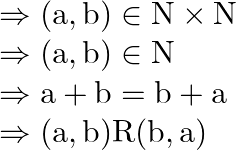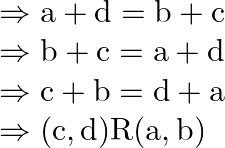Solution:
If ![]() is Reflexive, Symmetric and Transitive, then
is Reflexive, Symmetric and Transitive, then ![]() is an equivalence relation.
is an equivalence relation.
Reflexivity:
Suppose ![]() and
and ![]() be an arbitrary element of
be an arbitrary element of ![]()

Therefore, ![]() is reflexive.
is reflexive.
Symmetric:
Suppose ![]() and
and ![]() such that
such that ![]()

Therefore, ![]() is symmetric.
is symmetric.
Transitivity:
Suppose ![]() such that
such that ![]() and
and ![]()
![]()
![]() and
and ![]()
On adding both the equations we obtain

![]() is transitive.
is transitive.
As a result, ![]() is an equivalence relation.
is an equivalence relation.
